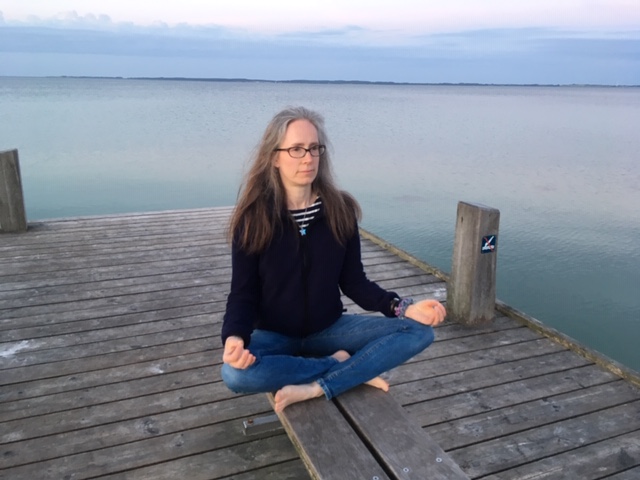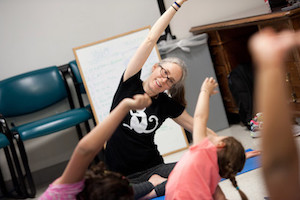Give yourself a break with meditation

Do you start the day with anxiety and end it by thinking about how the day’s good intentions went awry? You can rework this cycle through meditation. While meditation can’t hold back all the curve balls thrown into your life, it does offer a way to cope and adjust your perspective. We recently discussed how to start and sustain a meditation practice with Dr. Emily Davidson, a physician at Boston Children’s Hospital and a registered yoga teacher.
What are the basics of meditation?
I see meditation as both simple and challenging. There are many different meditation techniques and traditions but most share a few common elements:
- a quiet or non-distracting environment
- a comfortable position
- attention to a specific focus (such as a word, the breath, or an object)
- a passive or open, non-judging attitude
Even though meditation seems simple, it is not always easy to maintain your attention, especially when you first start. Our brains are designed to think. Naturally, thoughts arise during meditation. Part of having a non-judging attitude is to just notice the thoughts and let them pass. Each time you return to your focus you are practicing meditation.
How does a beginner start a meditation practice?
One simple answer is to just sit down and pay attention to your breath. Here are some ideas to get started:
- Close your eyes or keep your eyes open and softly focused a few feet in front of you. Feel the sensation of the breath going in and out. You can focus on the sensation of the breath at the edge of the nostrils or feel the abdomen expand and release while breathing.
- Counting with the breath can be helpful as well. Count one as you breathe in, two as you breathe out, three breathing in, four breathing out. . . up until 10 and then restart at one. If you find you have counted past 10, just notice that and return to one.
- Some people prefer using a word or phrase (mantra) as a focus (such as “peace” or “Om”). Words can also be attached to the breath (breathe in “here,” breathe out “now,” or breathe in “peace,” breathe out “calm”).
- It can be helpful to set a timer for 5 or 10 minutes as you first start to meditate. I like the “Insight Meditation Timer,” which is a free app that allows you to set background music and chimes, but the timer on a phone or microwave or an old-fashioned egg timer can work as well.
- Guided meditations can also provide a nice entry into meditation. Several apps offer free guided meditations.
- It is helpful to pick a time of day, such as first thing in the morning or before bed at night, to meditate. Choosing a place and time in advance and making it part of a daily routine can help the practice “stick.”
What are the primary benefits of meditation?
Meditation is beneficial for a wide range of different conditions. Many studies have supported its use for symptoms of depression, anxiety, and insomnia, as well as in patients being treated for cancer. There are also some promising results for those with chronic low back pain.
Meditation is also helpful for stress, as the process of meditation shifts the body from the sympathetic “fight or flight” response to the parasympathetic “rest and digest” response. For children and teens, meditation can help with self-regulation, coping, mental health symptoms, and blood pressure.
For me, the most important benefits are becoming more focused and less reactive. I find meditation helps me stay calm at work and at home and to be more present with the people around me. It does not take long to begin to notice the benefits — try meditation for 10 minutes a day for one week and see if you notice any changes.
Watch for upcoming meditation sessions at the Boston Children’s library, the chapel, and other locations around the hospital.

(KC Cohen/Boston Children’s)
Emily Jean Davidson, MD, MPH, RYT, is an assistant in medicine in Complex Care Service and the Down Syndrome Program at Boston Children’s Hospital and is an assistant professor of pediatrics at Harvard Medical School. She became a registered yoga teacher in 2011 and has taught an inclusive yoga class at Boston Children’s Martha Eliot Health Center (MEHC) since the fall of 2013. In 2014, she received funding from the Weiner Award at Boston Children’s Hospital to expand yoga at the hospital, adding Reiki, aromatherapy, guided body awareness meditation, and contemplative care services. She also teaches yoga at Boston Children’s Hale Family Center for Families and runs Adventure Challenge, a program that trains volunteers to provide yoga classes for families and one-on-one exercise coaching for children with disabilities.
About our bloggers: Maxine Milstein, MBA, is administrative director of the Boston Children’s Office of Faculty Development; Jill Dobriner, PhD, is Office of Faculty Development program coordinator.
Related Posts :
-

Keeping up with the tween skin care trend: What’s in those products?
More teens and tweens are hitting the mall to grab skin-care products they’ve seen on social media — but are ...
-

Firearm suicides in children and youth: A state-by-state look
At a time when mental health problems are skyrocketing, a new study provides one of the most comprehensive state-by-state accountings ...
-

Reversing the trend: Easing the mental health boarding crisis in emergency rooms
Anxiety, depression, and suicide attempts have been rising over the past decade, especially among teens, often landing them in emergency ...
-

Brain wiring predicted adolescents’ emotional health during COVID
The COVID-19 pandemic was emotionally devastating for many adolescents, disrupting their schooling and social/emotional development. Drawing on national data, ...





